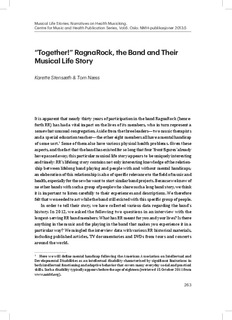Together! RagnaRock, the band and their musical life story
Chapter, Peer reviewed
Permanent lenke
http://hdl.handle.net/11250/196809Utgivelsesdato
2013Metadata
Vis full innførselSamlinger
- Artikler og bokkapitler [390]
Originalversjon
I: Musical life stories : narratives on health musicking, s. 263-287Sammendrag
Lifelong dedication and membership indicate in and of themselves how important RR has been for its members and leaders. In general, their musical life story is about the change of identity from clients to rock musicians, but this band’s narrative is also about so much more: certain music, rehearsal methods prepared especially for the band, instrumental learning, significant events and performances, feelings and experiences, even eye contact in rehearsals. The story is very personal and unique for each member, of course, and it contains more unexpressed experiences than the data collected for this study can ever reveal. However, a musical story as happy as RR’s derives as much as anything from sensitive and competent leadership. The leaders have all had several roles. First, they led the band itself, drawing upon musical, educational and therapeutic skills while playing instruments as well. Second, they had to be not only bandmates but friends or even mothers/fathers’. When conflicts occurred, for example, they had to negotiate resolutions. When the band went out on tours, they had to make arrangements by booking hotels and buying meals and so forth. But most of all it was the unique togetherness that made the RR story so happy, a togetherness that developed over years through a shared love of music, playing, and each other. RR is therefore an example of how we might create healthful personal and social capital through bonding and bridging for people with handicaps. The band has helped its members avoid isolation, which is today perhaps the biggest threat for people with handicaps, and as such, band participation has been an important component of health for them! Through our study of RR, we have also found it to represent a means of creative and aesthetic expression that allows for the performance of the self and the development of identity.12 This reminds us, as well, that playing in a band like RR offers an arena where people with various personal prerequisites can join in but remain who they are. In this sense, RR is an example of how to arrange for activities that accommodate basic needs and at the same time preserve human dignity. Mary Law (2002) quotes Adolph Meyer, one of the founders of occupational therapy, who speaks of the human being as an organism that maintains and balances itself in the world of reality by leading an active life. The use that we make of ourselves, says Meyer, “gives the ultimate stamp to our every organ” (Meyer in Law, 2002, p. 640). Therefore, arrangements like RR constitute powerful affirmations of everyone’s need to feel wanted, useful and needed.
Utgiver
Norges musikkhøgskoleSerie
Centre for Music and Health Publication Series;Vol:6NMH-publikasjoner;2013:5
